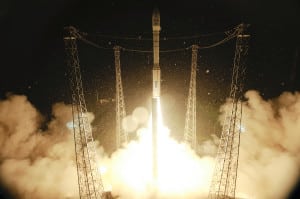Latest News
[Via Satellite 01-28-2015] With nine flights booked and three more in negotiations, Arianespace is confident it will have regular launches of the Vega small satellite rocket starting this year. The long-awaited demonstration of the European Space Agency’s Intermediate Experimental Vehicle (IXV), is currently planned for Feb. 11. Two more launches, one for a Sentinel satellite for the Copernicus program, and another for the LISA Pathfinder research satellite will round out 2015. Going forward, Arianespace anticipates conducting as many or more launches per year between now and the introduction of the Vega C next generation rocket.
“The idea is to fly Vega three to four times a year, so we are on a pace now to do three or four a year in the coming few years,” Clayton Mowry, president of Arianespace told Via Satellite. “The current planning shows a maiden flight for the upgraded Vega C version with the P-120 core booster in 2018. That same P-120 booster will be used on Ariane 6 which will provide us with economies of scale for manufacturing and launches.”
Mowry said Arianespace is seeing strong interest from the commercial sector after establishing Vega in the institutional market. Vega has flown three times to date, all successfully. The first carried the LARES and ALMASat 1 spacecraft along with seven CubeSats in three Poly-Picosatellite Orbital (PPOD) dispensers. The second launch carried Proba V, VNREDSat 1 and ESTCUBE 1, and the third lofted the Kazakhstan government’s KazEOSat 1 (DZZ-HR) satellite. Mowry said new contracts with commercial and institutional customers will be announced in the coming weeks.
In October 2014, Arianespace purchased 10 Vega rockets from the Italian manufacturer European Launch Vehicle (ELV). Three of the rockets are for ESA, with six more launches awarded to launch seven missions. Mowry said the customers that are interested in Vega have satellites for a variety of missions ranging from optical Earth observation to Automatic Identification System (AIS) to Global Navigation Satellite System Radio-Occultation (GNSS-RO).
“Big data seems to be the trend now with a lot of these companies, from startups to established operators in the SmallSat area. There are a lot of companies with different, new applications for these types of services and we are talking to a range of customers in that area,” he said.
Today Arianespace is launching missions ranging from 1,300 to 1,400 kilograms with Vega. The rocket is designed to do 1,500 kg to a theoretical 700 kilometer Sun-synchronous orbit, though performance depends on variables including configuration, target orbit, carrying structures and number of satellites/adaptors to be launched. Mowry said the P-120-equipped Vega C would increase performance by a planned 300 to 400 kilograms.
The company’s strategy for launching Vega is similar to the Ariane 5, in that multi-manifesting is expected to be the predominant business case. The Vega Secondary Payload Adapter (VESPA) carrying structure can fly two small class spacecraft by placing one in the upper and one in the lower position. Or several small satellites can fly together on top or on bottom, with the restartable Attitude and Vernier Upper Module (AVUM) capable of reaching a wide range of orbits.
“It’s a little more involved with Vega, but it’s more or less the same type of process,” he explained. “You match customers looking for the same launch periods and altitudes. For Earth observation missions lining up the local times (ascending or descending nodes) becomes important … that’s how we make that business work: by finding customers where someone is going to take the upper position, and someone is going to take the lower position, and by bringing those two missions together it is cost effective for both parties.”
Mowry declined to mention the price point for launch, but said it depends on satellite mass and the desired orbit. Popular orbits would allow for more competitive pricing, he said. The small satellite launch sector has grown in popularity in recent years. Lockheed Martin is returning to the sector with Athena, Orbital Sciences has customers for Pegasus, as does Virgin Galactic for LauncherOne, and new entrants such as Rocket Lab, Firefly Space Systems and Mishaal Aerospace are aggressively developing launch systems of their own. Mowry anticipates the small satellite sector will continue to grow impressively, creating a viable market for dedicated small satellite launches.
“I think if you look at the amount of private equity money that’s going into that sector, if you look at the excitement surrounding a number of these ventures based in Silicon Valley, San Francisco and other parts of the country, including some here in the D.C. area, you can see there is a tremendous amount of interest in the SmallSat sector, and a tremendous amount of newfound funding for new types of ventures. My prediction is that this sector is going to be growing, and growing quite rapidly over the next three to four years. We are going to see a lot of opportunity for Vega,” he said.
Get the latest Via Satellite news!
Subscribe Now